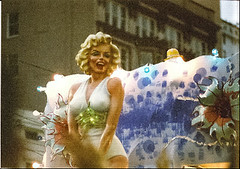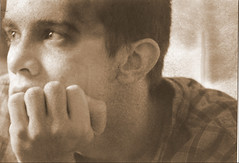Maternalism & the Female in My Favorite Wife (1940) and Meet Me in St. Louis (1944)
In My Favorite Wife and Meet Me in St. Louis the female characters possess what might be considered an unusual amount of strength given the time. Ellen Wagstaff Arden and Esther Smith each exude a strong maternal affection so naturally that it appears to be a given of a desirable woman of the day. Contextual cues also serve to negotiate these gender roles in a way indicative of the call for women, as Lynn Spigel observed, "by popular media to enter traditionally male occupations during the war." [2] Both Mrs. Arden and Ms. Smith were designed to appeal to women of the same class in an adventurousness that still allows room for the boy next door but not without some remediation. The way in each film approaches that design, however, varies considerably as will be seen.
A revisitation of the on-screen charisma exhibited by Cary Grant and Irene Dunne in The Awful Truth (1937) presents the audience yet again with two protagonists. When Ellen Arden turns out not to be dead and lost at sea, the recently remarried Nick Arden finds himself flummoxed and unsure what to do. While Ellen desires to have her husband and her family back, Nick's character holds the flaw that must be ground down and polished: wishy-washiness. By disguising Ellen as the antagonist to Nick's desire to have everything turn out well for everybody (without having to make any decisions), the writers (McCarey, Spewack, McClain and Kanin) reinforce the image of an ideal wife and mother who is essentially perfect, capable of the same things as her male counterparts and only awaiting for her man to grow a little backbone. He must find a classy way to annul his second marriage while she must find a way to re-enter the lives of her husband and children. In order to establish a sense of balance another man also gets thrown into the mix, someone with whom Ellen spent her years "lost at sea." By leveling the romantic playing field, the love story becomes more believable as the audience witnesses how much the idea of his wife spending seven years alone on an island with a strange man pains Nick, who subsequently all but forgets about his new bride.
While Meet Me in St. Louis uses a far more traditional context, its approach to conflict renders it unique and even strange perhaps to anyone unfamiliar with the semi-autobiographical novel by Sally Benson, upon which it is based, or the fascinating history of the city of St. Louis itself. Garland's character is the second of three older daughters hoping to marry the literal boy next door and subject ostensibly to the conflict of the Smith family's possible move to New York City for economic reasons. The move could break the tenuous love affair blossoming between Esther and John. Moods and romantic suggestions color the film through song and dance routines and that same ideal image of womanhood shines through as the men slowly but surely realize that they must speak up in order to get the girl. More importantly, Esther Smith shares an uncommon bond with an uncommon little sister whose psychological havoc with traditional gender roles scores darker notes in this otherwise light fare. While Esther dreams of first kisses and Christmas balls, Tootie executes her toy dolls stoically, even grimly, in an expression quite against the characteristic grain of the future mother, housekeeper or matriarch.
Most interestingly, nobody notices these odd quirks of the youngest daughter's nature, not even in a house with little breathing room and close female relationships. In this way, Tootie's actions symbolize a definite, closeted change in gender roles with a cloudy and indefinite future--a threat to the film's ideology as identified by Bordwell and Thompson. "...Meet Me in St. Louis, like most Hollywood films, seeks to uphold what are conceived as characteristically American values of family unity and life." Pointing out that the film's motif is one of static preservation, they further note that that "the home appears to be a self-sufficient place; other social institutions become peripheral, even threatening." It is also interesting to note that these acts on Tootie's part represent a deep unrest and a rift between the women of the family, a direct result of the external forces at play because of males actions--or inaction. While the outside world prepares for the advent of the 1904 World's Fair (i.e., the Louisiana Purchase Exposition) and horse-drawn carriages give the right of way to motorized vehicles, inside the Smith home "...women are portrayed as the agents of stability. The action in the story constantly returns to the kitchen, where Mrs. Smith and the maid, Katie, work calmly in the midst of small crises. The men present the threat to the family's unity."
Each of these films employ a mixture of perceptual and mental subjectivity. After witnessing the physical prowess of the man with which his wife lived on an island, Nick Arden's mental torture manifests itself in a hallucinatory image at once funny and indicative of his state of mind. Many of Minnelli's musical numbers could be construed as mental subjectivity as the audience listens to Esther's thoughts and ruminations through song. It might be said that while Meet Me in St. Louis relies heavily on mental subjectivity and My Favorite Wife upon perceptual subjectivity that each operate differently within their largely omniscient point of view. The audience almost always knows more than the Ardens at any given time, which is just part of the fun, but these two characters catch up on the facts as the story unfolds. The Smith sisters and their family and beaus are considerably more vague; the audience sees into each private life, but the web never quite connects on the screen. If the audience only considers the desires of Esther, though, the narration then becomes more restricted to her character's viewpoint, waiting with her to see if John Truett will make up his mind and things will work out somewhere between St. Louis and New York. In this sense, the omniscient view point reinforces the use of each character in its distinct position within the framework of the film's ideology and ostensible recipe for romance.
"Straight musicals," Bordwell and Thompson write of films like Meet Me in St. Louis, "are often romantic comedies, in which characters typically trace the progress of their courtship by breaking into song to express their fears, longings, and joys." Bordwell and Thomspon also note the connection between musicals and children's fare, a decidedly good point looking at Minnelli's film as a whole. Not only do children appear in the film prominently, but the recurrent idea of resistance to change conjures a romantic perception of childhood innocence and youth in general as something to be preserved and cherished lest it be lost forever. It often feels that musicals and love stories go so hand-in-hand because of the imperfect nature of words when trying to express strong feelings. Actions always speak louder than words, but what satisfaction can an audience derive from a love story in which no words connoting love or intimacy are exchanged? By the same token musicals provide more than a means to that expression; they also allow for intrigue between the characters to build as the audience becomes ever more privy to the character's desires and ever more aware of the growing love interest's ignorance. This romantic plot line insinuates itself naturally into the musical form--even when dealing with supposedly revolutionary characters in Hair (1979) or a platonic historical figure in Jesus Christ Superstar (1973) or a desperate and ultimately doomed love affair the likes of Moulin Rouge! (2001).
Bereft of musical numbers, romantic comedies--particularly the "screwball" comedy--employ more plot twists and devices to keep the audience intrigued. In order for a love story to be believable, both parties (according to Hollywood) must hold more than a passing interest in each other; they must each at least try to make the relationship work, even if only the audience can fully appreciate their attempts. Or, to quote the authors yet again, "The screwball comedy traditionally sets up a thematic opposition between a stiff, unyielding social milieu and characters' urges for freedom and innocent zaniness." The judge in the courtroom represents the law and authority and an indifference to the qualities that make this romance work--love, forgiveness and spontaneity--a recurring obstacle in comedies from His Girl Friday (1940) to Some Like it Hot (1959). The use of certain Foley sounds, such as pings that sound when something racy has been implied, also seem to be the sole province of the screwball comedy; and, unlike the musical genre, the story determines the film's general reception as the audience relies more on the character's interaction rather than their ability to emote through song and dance routines.
To return to Spigel's words concerning the changing gender roles in World War II's America for a moment, it seems a good bet that a lot of the dialogue in My Favorite Wife was crafted with that shift in mind. The judge/authority figure frowns upon Ellen Arden's role, but is more confused than condemning. She retains her maiden name (Ellen Wagstaff Arden) perhaps as part of her role as a former Southern belle, but probably also symptomatically of a new way of viewing the woman's role in a marriage. Her role as a mother demonstrates itself as an egalitarian negotiation between her and her husband that keeps what's best for the children in mind but does not usurp the romantic ideal of being a woman first and a mother second--despite the twin beds in the marital chamber. [3] In other words, explicitly a woman has to grapple with her various roles but implicitly a woman's strength of reason and resolve create a home in which a man can either snuggle up or leave to find a new mate. In contrast, the maternal strength in Meet Me in St. Louis manifests itself much differently. If the outside forces of the world--a world run by men--present a threat to that strength, the period piece musical acquires a new dimension non-existent in the screwball comedy, a defiance of a perceived societal shift. Where the screwball comedy interacts with that shift, the musical seeks to trap and distill it--crystallize it--and let the world see what it is that they will be forever missing.
[1] Bordwell, David and Kristin Thompson. Film Art: An Introduction. Eighth Ed. McGraw Hill: University of Wisconsin. 2006.
[2] Spigel, Lynn. Make Room for TV: Television and the Family Ideal in Postwar America. The University of Chicago Press: 1992. (All excerpts Chapter 2: Television in the Family Circle)
[3] This ideal female image would re-prioritize those roles in the post-war era. Spigel discusses the reaction to the undermining of the male's assumed authority in the household and workplace thus: "...women were given a highly constraining solution to the changing roles of gender and sexual identity...Marynia Farnham and Ferdinand Lundberg's The Modern Woman: The Lost Sex (1947) gave professional, psychological status to the housewife image, claiming that the essential function of women was that of caretaker, mother, and sexual partner. Those women who took paid employment in the outside world would defy the natural order of things and become neurotics...The domestic woman needed to save her energy for housekeeping, childrearing, and an active (monagamous) sex life with her husband."
Labels: Bordwell and Thompson Series, Film, Musical, Screwball Comedy























